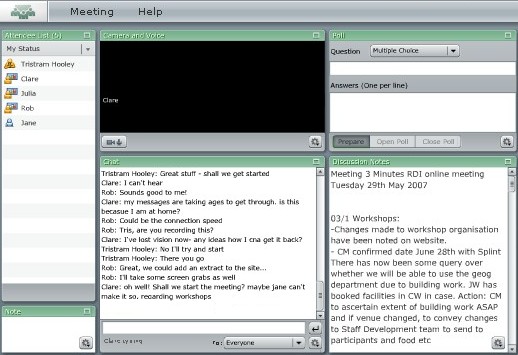![]() Click on the headings to open them. They will open on this page. Open the following link
for further
information about these headings if required.
Click on the headings to open them. They will open on this page. Open the following link
for further
information about these headings if required.
Your browser does not support these headings. To ensure that the contents remain accessible, they have been automatically opened so that all the information on the page is displayed.
However, to take advantage of the headings and to ensure that the layout and design of this site are displayed correctly, you are recommended to upgrade to a current version of one of the following standards compliant browsers:
- Internet Explorer (http://www.microsoft.com/ windows/ie/downloads/ default.mspx)
- Mozilla Firefox (http://www.mozilla.org/ products/firefox/)
- Opera (http://www.opera.com/download/)
 Face-to-face
meetings
Face-to-face
meetings
Face-to-face meetings were held every 6 months in which the project was managed in a fairly conventional manner. These meetings were time and cost intensive but very productive and particularly important at the start of the project. The meetings were important for bringing the locationally distant team together and for keeping up rapport and enthusiasm for the project.
 Asynchronous
email discussions
Asynchronous
email discussions
Regular email contact was kept between members of the team, on an individual and group basis, to keep up with the day-to-day running of the project. Email discussions were a quick and efficient way in which to discuss planning details for the project.
 Example
Example
Email from Clare Madge to the TRI-ORM team, May 2007.
All,
Please find attached the minutes (see minutes 3) I have culled from the online meeting!
Also, I am going to ask Rob to add a section on project
organisation on the following page
http://www.geog.le.ac.uk/orm/background/tri-orm/tri-orm.htm
Some ideas are attached, but if you have anything more to add, please do so, in red, and return to me by Monday 4th. Julia, I don't know if you want to beef out the evaluation section a bit more?
Cheers,
Clare
 Synchronous
real-time meetings via a Virtual Learning Environment (Blackboard)
Synchronous
real-time meetings via a Virtual Learning Environment (Blackboard)
As our project was all about using an online methodology, we decided to attempt to project manage in the online environment. The first synchronous meeting was via a virtual learning environment (Blackboard) in May 2007.
 Advantages
and disadvantages
Advantages
and disadvantages
Clare Madge compiled the following list of advantages and disadvantages following personal reflection and feedback from the team:
Advantages of the online meeting were:
- Saving travel costs
- Saving travel times
- Instant feedback
- Felt like a real meeting
- Overall enjoyable experience
- Although a bit disjointed we probably got through as much as we would have done in 1 hour f2f meeting
Disadvantages of the online meeting were:
- Access problems from some members of the team off-campus.
- Technological glitches – such as not being able to get the whiteboard up and the whole window being much too small.
- Slightly put off by speed of interactions and found it difficult to keep up with discussion
- Appalled and embarrassed by poor typing at speed- no time to spell check
- No body language
- Weakness of text based interactions
- Difficulty of controlling interactions in synchronous environment so threaded discussion a bit confusing at times
- OK for factual type issues but not for detailed pedagogic issues
- Distractions in office - had to keep saying sorry I'm in a meeting!
The team decided to persevere with the online meetings in the hope they would become easier as the technology become more familiar. However, some of the technical problems outlined above prompted the decision to try alternative software for the meetings.
 Synchronous
meetings via Adobe Connect
Synchronous
meetings via Adobe Connect
The Adobe Connect software was chosen for subsequent meetings as it was available at the University and it was felt that it would provide greater and easier opportunities for file-sharing and use of whiteboard technology, as well as providing scope for audio and video communication.
 Screenshot
Screenshot
Image of the Adobe Connect interface from the perspective of a participant. The attendee list is shown on the left with the following windows, shown clockwise from top-left:
- The camera and voice window in which video images and audio is viewed where participants have web-coms (not used in this meeting)
- The 'Poll' window in which participants can vote on a number of choices in response to a question.
- The 'Discussion notes' window in which the minutes of the meeting were recorded collaboratively.
- The main 'Chat' window in which the text-based communication took place.

Screen capture of team meeting carried out using Adobe Connect
Despite some initial teething problems for members of the team accessing the system off-campus, the system provided a more robust and usable framework for future online meetings. The team became increasingly comfortable with the technology and the use of written chat-based interaction. This allowed some of the disadvantages of the online meetings to be overcome and ensured that the online meetings provided a useful method of steering the project between face-to-face meetings.

